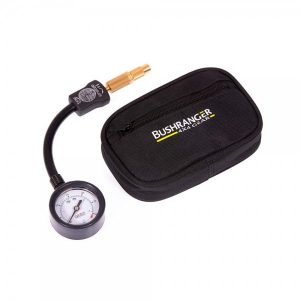There are three short answers to this. First, check your Owner’s manual and follow any manufacturer’s recommendation if applicable. Second, change all caravan tyres that are over 10 years old regardless of tread depth. Lastly, it depends on the actual condition of your tyre. Therefore, you need to know what makes a tyre considerable for replacement.
BLOG CONTENTS
Factors to consider in determining when to change caravan tyres
- Proper tyre size, type and load capacity (or load range)
- Appropriate vehicle loading
- Proper inflation pressure
When and how to check for inflation pressure
When you change your caravan tyres, use the same brand and model that were originally fitted when you bought your caravan (i.e. OEM tyres). That way, you’ll be meeting the original specifications as intended by the manufacturer. This too will spare yourself the trouble of going back and forth between brands and getting overwhelmed by oh-so-many tyres.
But if you wanted an upgrade or just looking for a suitable alternative tyre, think of how often you use your caravan, and at what terrains you usually travel to. Those will be your basis for gauging how much you need to exceed the minimum required tyre specifications. After that, you may proceed to check out the factors below.
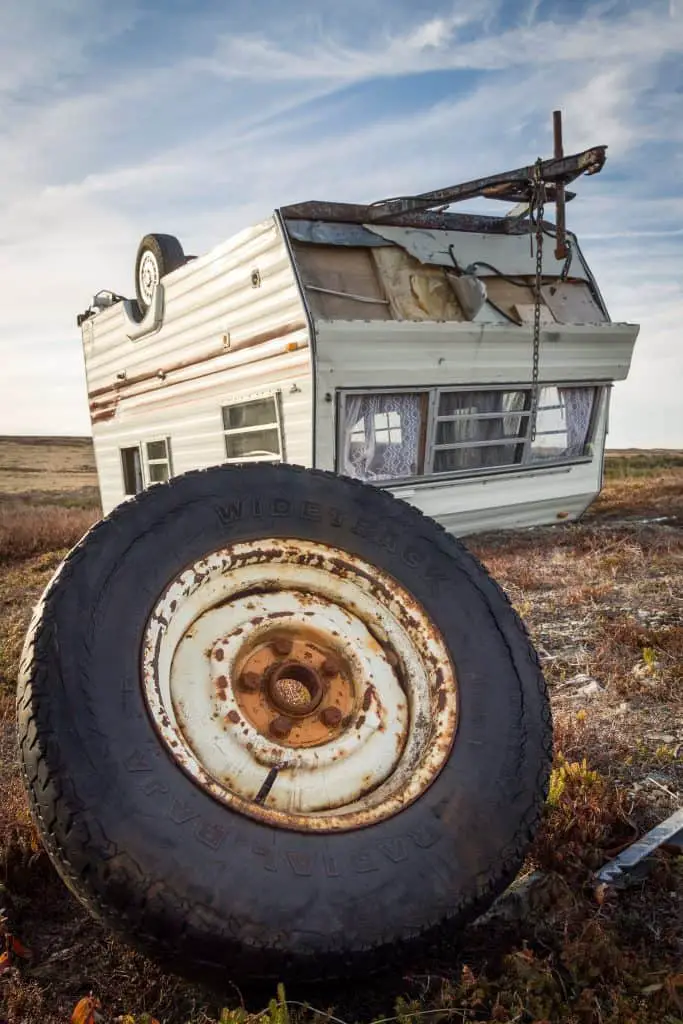
Photo by Erik Mclean from Pexels
Factors to consider in determining when to change caravan tyres
According to the Michelin Australia Team, the most important factors in tyre safety, performance and service life are:
- Proper tyre size, type and load capacity (or load range)
- Appropriate vehicle loading
- Proper inflation pressure
- Regular tyre rotation
- Regular inspection and good driving habits
- Proper tyre repair
- Vehicle condition, alignment and maintenance
These will be your guide in determining when exactly should you change your caravan tyres.
1. Proper tyre size, type and load capacity (or load range)
Light vehicles and trailers are required to be fitted with a Tyre placard. This plate contains tyre information that the vehicle must comply with. The placard must include tyre size, tyre load rating, speeding rating and cold inflation pressure at a minimum.
The Michelin Australia Team advises that the tyre placard should be respected when changing tyres on caravans and trailers, just like in any other vehicle.
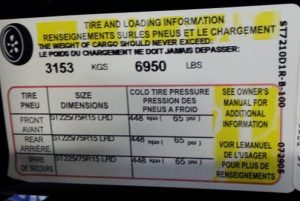
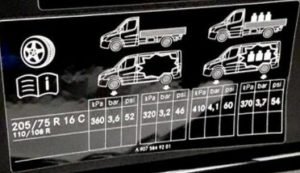
As to the matter of choosing the right type of tyre for your caravan, the Michelin Australia Team reveals that:
The loads on caravan tyres are generally higher than passenger vehicles, therefore tend to require light truck tyres.
There you have it. As a new vehicle owner, it might be difficult for you to choose online which tyre suits your caravan the best. All the more that tyres come in different types, sizes, brands and unique features.
So when choosing the right tyre for your caravan, a good place to start with is by looking at light truck tyres. They generally have a greater capacity to handle heavier vehicle weights than car tyres do. And then filter those with the requirements indicated in your existing tyre placard.
As to size, tyres are labelled in terms of load index. The higher the load index, the greater weights the tyre can handle. Again, follow the tyre size indicated in your tyre placard. If you think your tyres look too small, you may notch things up a bit subject to the Manufacturer’s allowable range and/or a tyre expert’s approval. For more information on tyre labelling, visit Tyroola’s guide. It will explain all the details you’ll need to know and how to find them. Highly recommended as a good source of information.
2. Appropriate vehicle loading
Right, so given that you have already determined the right tyre for your caravan – what’s next? Appropriate loading, of course. This is loading the heavies items the closest to the tyres and axles. When loading your belongings (or even installing additional fixtures) in your caravan, do NOT just shove them off to one corner. That’s a no-no especially when these items or fixtures are heavy.
Instead, load your caravan in a balanced way – that is, equally distributed among your caravan’s axles. Specifically,
-
- Place your heaviest belongings directly above (or close to) where your caravan tyres are.
- The second priority is to place the next heavy items along the direction of the axle/s (i.e. the line/s that connect/s your tyres on the left to the tyres on the right).
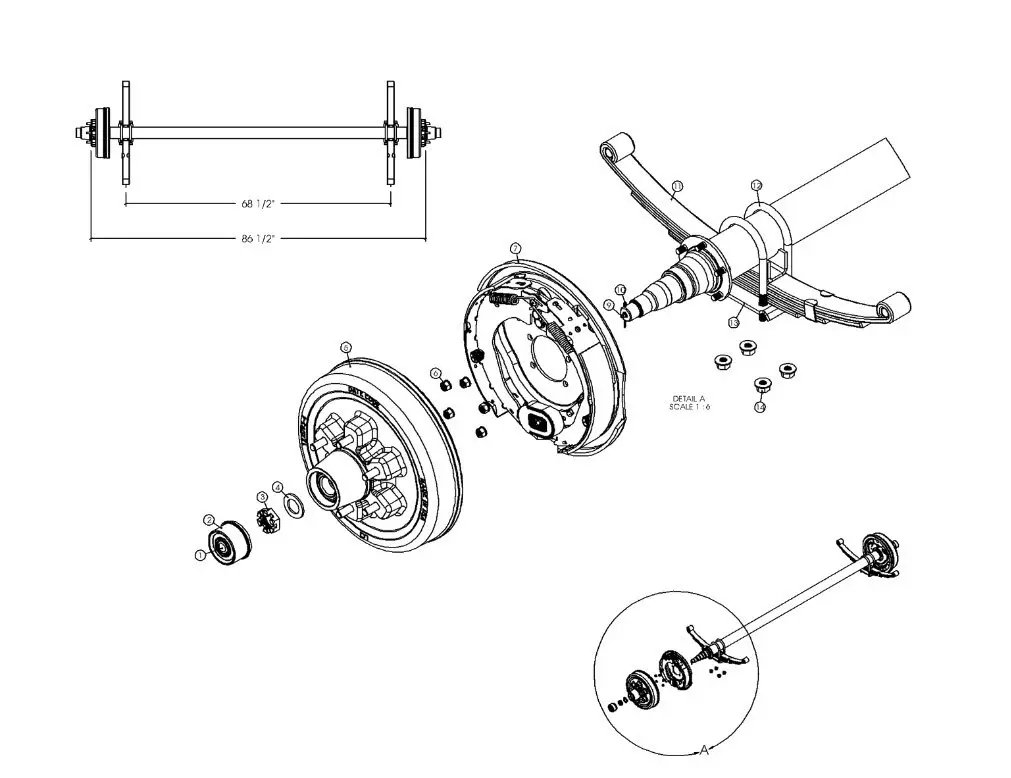
Vehicle Axle
Vehicle loading is the greatest factor that affects a tyre’s performance. Therefore, if you load your caravan within its weight limits and in a balanced manner, the less frequent will you need to change your tyres.
3. Proper inflation pressure
An underinflated tyre requires greater work to keep your caravan moving. That results in hotter tyres, higher fuel consumption and early wear on your tyre’s outer edges.
On the flip side, an overinflated tyre might burst not necessarily right after inflation, but while driving especially in hot conditions and high temperatures. Remember that air expands when it’s hot.
While underinflated tyres are more susceptible to wear, overinflated tyres are more prone to puncture.
In any case, it will be hard to properly navigate and brake when driving under the wrong inflation pressures. That’s because your vehicle’s anti-lock braking system and other safety/control features depend on the tyres’ pressures for proper operation.
Not only should you look at your tyre pressures individually, but also as a whole. Seasoned drivers tend to develop a sense of balance between their tyres. Meaning, they could get all their tyres inflated right but still sense that it’s not somehow balanced.
So how does that help? When you can determine that your vehicle is somehow off-balance even after getting the tyre pressures right, this could mean one tyre is badly worn causing the off-balance feeling.
The thing is when you replace your caravan tyres with a different brand or specifications from those specified in your Manufacturer’s plate – your proper inflation pressures will likely change.
-
- To handle such a case, ensure that you have consulted first with a tyre expert before replacing your tyres with a different brand or specs.
- But if you happened to buy already a different tyre on your own, do the same – consult the expert of the store you bought it from and seek confirmation or solutions.
When and how to check for inflation pressure
Conduct your pressure checks at least monthly, and when your tyres have rested enough (at least 3 hours after driving). When towing, your caravan tyres work a lot to keep your caravan moving. So, as a matter of course, they heat up and their air pressures change. Basically, your reading won’t be accurate when you measure your inflation pressure on a hot tyre.
The most common option is to go straight to a nearby petrol station to check your tyre pressures. An alternate option is to use portable pressure gauges. Typically, these handy gauges have also the ability to deflate some air from your tyre. That will indeed be useful when you’ve got an overinflated tyre. But if you’ve found out that it’s underinflated, go back to option one.
Bushranger Tyre Deflator & Gauge
4. Regular tyre rotation
It’s quite funny but let me make it clear: Tyre rotation is not the spinning of tyres. Instead, it’s the exchange in the position of tyres from one axle to another – just like swapping and resting players in a big sporting match.
Even if it’s called “rotation”, it does not necessarily mean rotation (i.e. jumping from one position to the next adjacent position). A tyre may be relocated to its opposite diagonal direction.
Also, it’s preferable to rotate two tyres at a time rather than one, especially for 4WDs. But since we’re talking about caravans here (the most basic of which have three wheels only), it’s unavoidable that a literal rotation happens. Tyroola presents a straightforward guide on how to do the right tyre rotation.
Now, what is its purpose anyway? I’m pretty sure you’ve guessed it already, but let me confirm it. It’s to even out the wear on your tyres. That way, they will last longer because then again – it’s advisable to replace all your tyres at the same time.
How often should you rotate your tyres? It depends on how frequent you use your caravan. But a good figure to start with is every 6 months or 10,000km. After that, you may gradually make it more frequent to up to every 5,000km.
5. Regular inspection and good driving habits
Well here’s the irony:
A maintenance check does not examine only the condition and performance of the tyre or vehicle. Rather, it also involves the assessment of the vehicle owner’s performance.
So there. Include yourself in your maintenance checklist. Check which of your practices might have caused harm to your tyre, causing an untimely replacement (and expense). Consequently, never forget to include your spare tyre in your maintenance checks. It’s a misnomer to neglect to check them just because you don’t use them. But you want to be let down with a flat spare just when you need it the most.
Good tyre handling practices
When encountering a sudden tyre puncture or blow-out, do not panic and hit the brakes hard. This can cause the vehicle and/or caravan to become unstable and may result in an accident. Instead, keep your hands to the steering wheel and the vehicle uncontrol and gradually slow down until you can safely pull over.
When having detected early a small puncture, bulge, crack or tear in your tyre, immediately consult a tyre expert to know what can be done. Most of the time, these may be repaired. But when consulted too late or continued to be driven on, they may need replacement.
Abide by the operating conditions specified by the manufacturer. If you feel something’s off when driving under such specifications, consult a tyre expert or mechanic. It’s better to be safe than sorry. There could be other components at fault like suspension, wheel bearings or rims just to name a few.
As much as possible, replace all your tyres at the same time. The key goal here is to keep your tyres uniform. When your circumstances allow only the replacement of some tyres, place the new ones at the rear axle for your trailer and steer for the towing vehicle.
Tyres are a roadworthy item and if worn or non-compliant, will render the caravan unroadworthy. Check with your insurance provider if worn or faulty tyres are included in your insurance package. This is commonly overlooked, this can be a great hassle. If you have yet to choose the right insurance provider for your caravan, check out my comparison tips.
Regularly inspect wheel nuts and valve caps. You will never want any of your tyres to suddenly loosen up while on the road. It’s as scary as an actual crash.
Change to winter tyres when the season calls for it. These have a better grip than the regular ones.
Even household tyre manufacturers get mistakes in their production quality. So, do check if the tyres you’re using or buying have a recall record. Product Safety Australia publishes which tyres are recalled to date, and how to deal with such cases.
6. Proper tyre repair
Tyre professionals follow the Australian Standard AS 1973-1993 to determine if a damaged tyre can still be repaired, and what tools to use. Some examples include:
-
- Although depending on their nature, punctures that are at least 6mm large should not be repaired.
- Multiple punctures may be repaired only if they are at least 400mm away from each other.
- Tyres that are proven to have undergone previous faulty repairs must not be repaired.
- Damages on the centre tread may be repaired, but those on the shoulder and sidewalls are irreparable.
There are many others, but the gist here is that it’s up to your good judgment and research whether a particular tyre provider is credible enough to meet your standards or expectations.
7. Vehicle condition, alignment and maintenance
Your tyre condition does not depend only on how you take care of it, but also on how you take care of your caravan as a whole. They’re interdependent like the parts of your own body. Let’s take our previous example – what good would it be if you have the best spec tyres but an overloaded caravan? Your tyres will tend to work a lot more than they should, leading to an increased rate of wear and higher fuel consumption. All those relate to a greater safety risk so in the end, you get the short end of the stick.
Have you ever struggled with pushing a shopping cart because its wheels just won’t cooperate with you? Typically, the wheels of shopping carts can rotate 360 degrees and not fixed to one direction. Now that same struggle happens with your caravan when your tyres are not properly aligned. It is worth noting that vehicle tyres need not necessarily be exactly parallel to one another. Each type has different inward/outward angle ranges to comply with.
The NSW Road Safety Transport department recommends that tyres be aligned about once a year, unless your circumstances call for a more frequent alignment.
Lastly, nothing beats a piece of well-maintained equipment or belonging no matter what kind it is. It’s the best and simplest way to extend an equipment’s shelf life. Previously, I have already shared tips on the good practices in handling tyres. And note that good maintenance means, “checking out your equipment’s condition even if it looks fine in the naked eye”.
8. Tread depth
In addition to the other factors mainly listed, I would like to add here tread depth.
The Australian government requires at least 1.5mm of tread depth on all tyres. Failing to meet this may cause your tyres to be difficult to control because tread depth determines your tyre’s grip strength on wet roads. Giant energy and petrochemical company Shell explains that tyre treads clear out the water layer that comes in between the road and the tyre. As a result, there will be fewer occurrences of slippage and the tyres would be easier to control.
Naturally, you must ensure that your tyres have similar tread depths for uniform balance. Imagine a juggler struggling with balls that aren’t uniform. The case is similar to caravan tyres.
Consider changing your caravan tyres as early as when your tread depth is at 3mm. Tyroola reports that your tyre’s performance exponentially drops beyond that 3mm mark.
How to check for tread depth:
-
- Use the depth indicators in your tyre and assess as instructed in your Owner’s manual.
- Bridgestone Australia describes an awesome alternate tip using an Australian 20-cent coin. Just insert the coin along with one of the tyre’s main grooves and in such a way that the backside of the coin faces you. When you see that the bill of the platypus does not reach the tread, then it’s time for you to consider quickly replacing your tyres (i.e. your tread depth is less than 3mm).
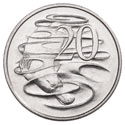
Australian 20-cent coin
Source: Royal Australian Mint
You may opt to start with a monthly check on your tread depth when your tyres are new. As you approach closer to the 3mm mark, gradually make your check more frequent (e.g. before every trip).
Summary
Again, it’s hard to set an interval as to how often should you change your caravan tyres. That’s except for the 10-year old range I mentioned above, and for the Manufacturer’s recommendation in your Owner’s manual. Outside of that, the exact time to determine when should you change your caravan tyres depends on the result of your (or a tyre professional’s) assessment. Therefore, in summary, conduct maintenance checks or activities at these minimum intervals:
- Inflation pressure check – monthly
- Tyre rotation – every 6 months or every 10,000km
- Alignment – yearly
- Tread depth check – monthly

